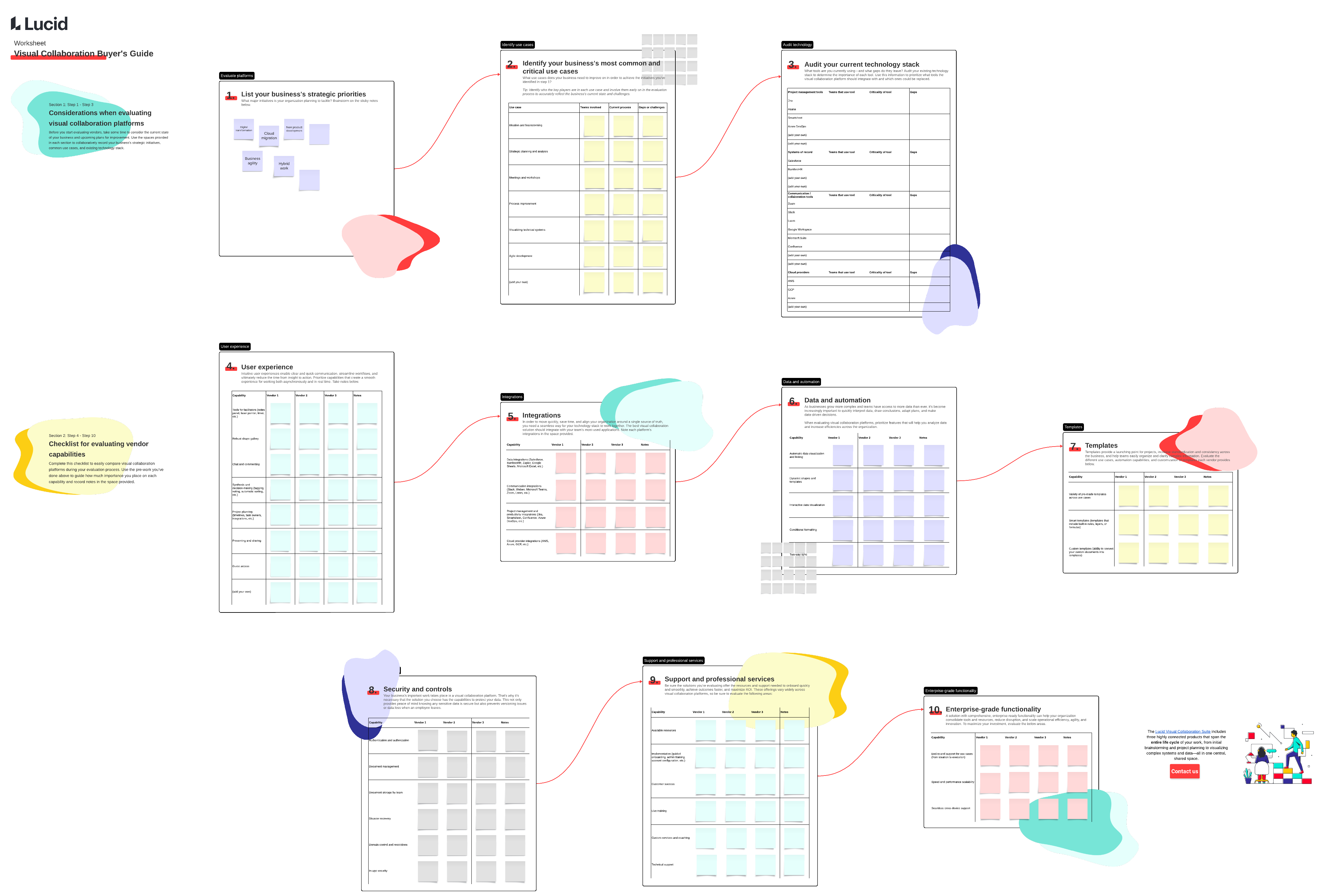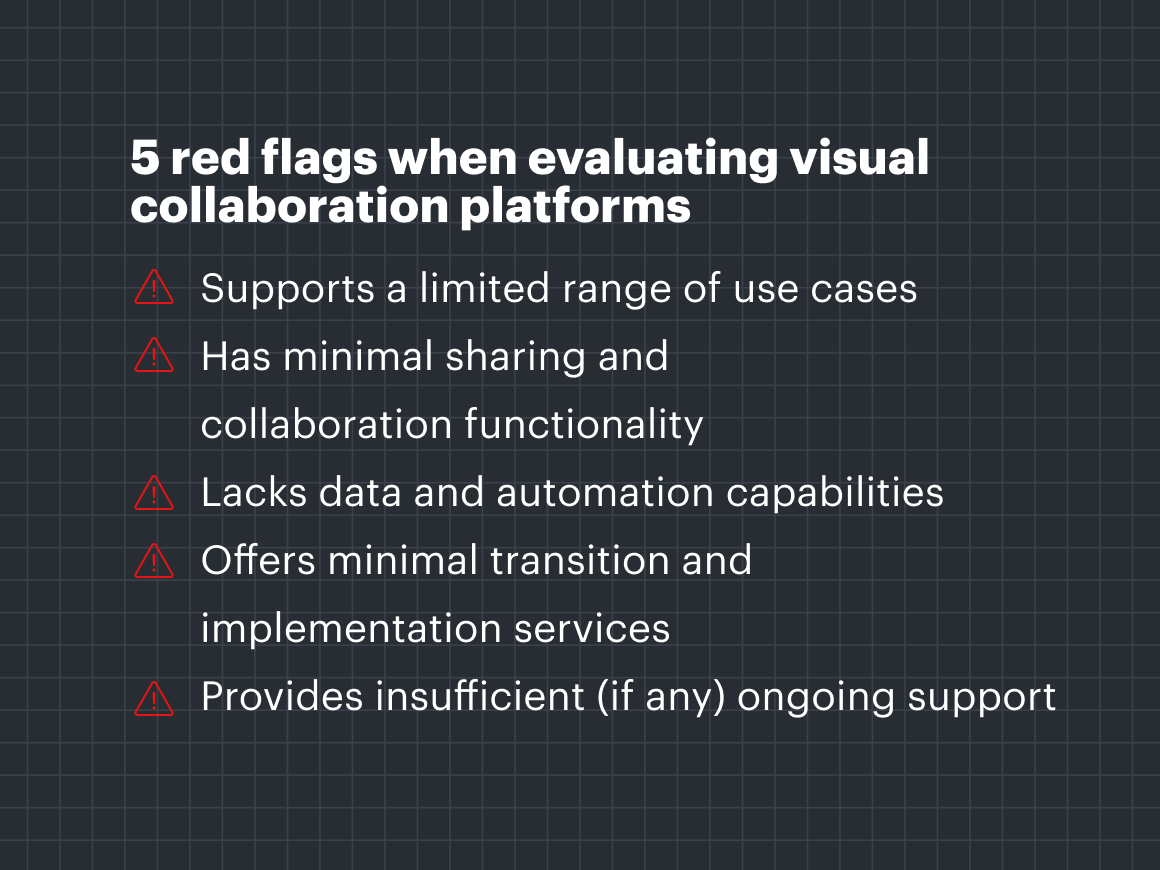
5 red flags to look out for when evaluating visual collaboration platforms
Reading time: about 9 min
Topics:
Not all visual collaboration platforms are created equal.
In fact, many tools bucketed under the visual collaboration category, such as digital whiteboards, lack some of the most crucial functionality needed to fulfill the promises of visual collaboration: increased innovation, productivity, and alignment.
But when software providers use the same language to refer to vastly different offerings, it’s hard to cut through the noise. How can you determine:
- What capabilities will drive, not hinder, innovation?
- What’s needed to connect cross-functional teams, not create more silos?
- Which visual collaboration solutions will truly increase efficiency across the business, not only in individual teams?
Visual collaboration software should be the cornerstone of how your organization gets work done, but the wrong platform could cost your business in the long run.
This guide is intended to help you see past the buzzwords, spot the red flags, and, ultimately, choose a visual collaboration platform that lives up to its promises.

What visual collaboration is (and is not)
Visual collaboration is far more than sticky notes and shapes. Learn what actually constitutes visual collaboration.
Read the blogHow to spot red flags in visual collaboration platforms
Every business has unique needs to fulfill—maybe you’re trying to increase agility or you’re navigating a return-to-office policy. Of course, it’s important to take this into account when evaluating vendors (and we’ve created a visual collaboration worksheet to help with your assessment).
But there are consistent weaknesses in visual collaboration software that will impede your progress, regardless of what unique goals are on the horizon for your business. Here’s how to spot those weaknesses before you commit to a visual collaboration solution.

Red flag #1: Only supports a limited range of use cases and teams
Some visual collaboration tools can help with ideation and meetings but lack the technical capabilities that teams need to understand their databases, architecture, or anything more complex. Then others cater almost exclusively toward technical teams, lacking the easy-to-use interface other teams need to jump into work.
In this circumstance, you’d need more than one visual collaboration tool to support your business. And maintaining multiple tools is not only costly but also makes it difficult for teams to collaborate cross-functionally, stifling innovation and slowing down progress.
How to spot this red flag
Most visual collaboration platforms will claim to support the entire business, so you’ll have to dig deeper than a product’s website to uncover if it really does cover every team’s use cases.
Start by determining the most critical use cases that teams across your business need to meet. Work with these teams closely to identify any gaps or challenges they face that a new solution would need to solve. For instance, you may find that teams track important data in Google Sheets or systems like Salesforce but struggle to glean insights from the data.
Use what you uncover to create evaluation criteria. In the example above, you may determine that certain integrations and data visualization capabilities would be key components to look for in visual collaboration software.
With your use cases in mind, we recommend digging into the following questions:
- Does the product have templates and shape libraries for your most important use cases?
- Does the platform have both diagramming and whiteboarding capabilities? Note: You’ll want to investigate the depth of each offering. Many technical teams will need intelligent diagramming capabilities (including data visualization and automation) as simple diagramming doesn’t fulfill their complex use cases.
- How does the product help teams move from ideation to planning?
- How does the product help with decision-making?
- Does the platform offer integrations to support your most critical cases? (For example, a Jira integration may be critical for Agile teams.)
According to Constellation Research's report, “The Leading Trends in Visual Collaboration for 2024,” diagramming features are essential to aligning teams on more complex use cases, such as product roadmaps, strategic planning, wireframing, enterprise architecture, or database diagrams. The report states:
“Allowing for these more complex use cases as well as more unstructured collaboration such as brainstorming to exist in the same platform helps organizations remove silos often found between departments, better enabling alignment on cross-functional initiatives.”
Red flag #2: Has minimal document sharing and collaboration functionality
You can’t have visual collaboration without, well, collaboration. Yet some platforms have undervalued this critical aspect, creating unnecessary barriers to working together and aligning. For example, some tools restrict users’ ability to edit documents simultaneously, leading to versioning issues and misalignment.
Or, they require users to take extra steps just to share documents with one another, which is inefficient and takes away time from high-value collaborative activities.
How to spot this red flag
Robust collaboration functionality in a collaborative platform should be non-negotiable.
To expose limitations that could create difficulties for your teams, ask:
- How can users share documents within the platform?
- Can teams invite partners, customers, or other external stakeholders to collaborate within the platform?
- How does the product support both real-time and asynchronous collaboration?
- How does the product help create a single source of truth?
- How are documents stored? And how are they secured?

Red flag #3: Lacks data and automation capabilities
Intelligence—that is, the ability to visualize data and automate parts of the workflow—is one of the most powerful capabilities in a visual collaboration solution.
Unfortunately, many visual collaboration tools don’t prioritize intelligence. Sure, many are experimenting with incorporating AI into their platforms—but to get the most value out of a visual collaboration platform, you need intelligence at every step of the workflow.
Constellation Research’s report highlights the importance of data visualization—a functionality that’s often overlooked in many tools—in the future of work:
“Visualizing complex datasets in easily digestible formats such as charts, graphs, and infographics not only simplifies understanding but also facilitates deeper discussions and brainstorming sessions based on the data.”
How to spot this red flag
At face value, many of the solutions may seem very similar. And as AI gains popularity and more platforms boast “intelligent” capabilities, it becomes challenging to identify which solutions will genuinely help your business.
If you can understand a platform’s technical capabilities (or lack thereof) upfront, you’ll avoid frustrations down the road.
To spot this red flag, use the following questions to guide your discovery process:
- Does the product offer bidirectional syncing with any other tools?
- Does the product have the ability to turn data into diagrams, and if so, from what data sources? Consider asking about specific use cases, including org charts from an HRIS, ERDs from SQL, or custom visuals from spreadsheets or CSVs.
- Can users interact with data visualizations within the product?
- Will the product support standardization by consolidating data from multiple sources?
- What automation capabilities does it offer at different workflow stages—ideation, planning, designing, decision-making, and monitoring results?
- Does the product offer open APIs to allow you to build your own integrations as custom use cases arise?
- Can data be visually organized using conditional formatting, colors, and layers?
- Does the product meaningfully leverage AI to automate manual work and move projects forward faster?

What makes a visual collaboration platform intelligent, anyway?
Learn more about what intelligence features are most valuable to the business and see what use cases only Lucid can support.
Learn moreRed flag #4: Offers minimal transition and implementation services
There’s no doubt that implementing a new tool represents a significant change in the business. Teams often need time, training, and resources to adjust to a new way of working.
Without the proper transition and implementation support, teams may lose important information they had in previous tools—or they might not adopt the new platform at all, exacerbating the collaboration and alignment problems you’re trying to solve in the first place.
How to spot this red flag
To ensure your organization adopts (and sees value from) the new tool quickly, dig into what services they offer to help streamline the transition to their platform.
You can ask the following questions to uncover this red flag:
- What migration support does the platform offer for transitioning from another tool? Do they offer both self-serve and white-glove options?
- What training do they provide to help teams learn the new software?
- What resources are available for teams to learn how to best apply the solution to their work?
- Does the software offer out-of-the-box templates? Does it offer services to create custom templates as well?
- What’s the process for exporting data out of their system to another? Hint: It’s equally important that the tool doesn’t lock in your work if you need to transition in the future—if they don’t offer easy exports, that’s another red flag!
Red flag #5: Provides insufficient ongoing support
Just as transition support is necessary to help teams initially adopt and use the new tool, ongoing support is needed to ensure teams continually see the full value of the software.
If teams don’t have sufficient resources to answer their questions and help them troubleshoot issues, they’ll likely become dissatisfied and frustrated. And if they attempt to create or find more workable solutions, there’s an increased chance of shadow IT or new security risks popping up.
How to spot this red flag
Don’t wait until it’s too late to discover that a solution lacks ongoing support.
You can identify this red flag when evaluating platforms by asking:
- Do enterprise accounts get a designated customer success manager?
- Where can users go when they have questions or issues?
- How much custom configuration is required to use the tool?
- Does the platform offer a community or space for admins and power users to ask questions and identify best practices?
- Is the product available in multiple languages? This is an important consideration for multi-national or growing organizations.
- Who is responsible for updates: the vendor or admin? Tip: In cloud-based solutions, updates, new features, and bug fixes are typically employed to all users automatically, so everyone is always working off of the latest version. With many desktop solutions, users or IT teams are responsible for this process.
Choosing the right visual collaboration platform for the future of work
Visual collaboration solutions have skyrocketed in popularity over the past few years as organizations have recognized their value in promoting collaboration for diverse working styles and environments.
As visual collaboration software becomes commonplace, choosing the right platform grows increasingly important to your organization’s success. In fact, the visual collaboration platform you pick could be what sets you apart from the competition—the key to gaining insights faster, working more efficiently, and continuously innovating.

Visual collaboration buyer's guide
Learn how to choose the right visual collaboration platform for your business.
Download the guideAbout Lucid
Lucid Software is the leader in visual collaboration and work acceleration, helping teams see and build the future by turning ideas into reality. Its products include the Lucid Visual Collaboration Suite (Lucidchart and Lucidspark) and airfocus. The Lucid Visual Collaboration Suite, combined with powerful accelerators for business agility, cloud, and process transformation, empowers organizations to streamline work, foster alignment, and drive business transformation at scale. airfocus, an AI-powered product management and roadmapping platform, extends these capabilities by helping teams prioritize work, define product strategy, and align execution with business goals. The most used work acceleration platform by the Fortune 500, Lucid's solutions are trusted by more than 100 million users across enterprises worldwide, including Google, GE, and NBC Universal. Lucid partners with leaders such as Google, Atlassian, and Microsoft, and has received numerous awards for its products, growth, and workplace culture.
Related articles
The hidden costs of Microsoft Visio (+ why Lucid is a better investment)
Evaluating Lucid and Visio? There’s a lot more to consider than upfront cost.
Beyond the buzzword: What is visual collaboration?
It’s time we stop treating visual collaboration like a buzzword. Defined properly, it's the key to aligning teams and accelerating innovation.
Hidden costs of Miro: Why Lucid is more cost-effective
Miro and Lucid are two big names in the visual collaboration space, but which one wins in terms of cost-effectiveness?
What makes Lucid the most intelligent visual collaboration solution—and why does it matter?
From data-backed visualizations to automation and AI, find out what makes Lucid the most intelligent visual collaboration solution.